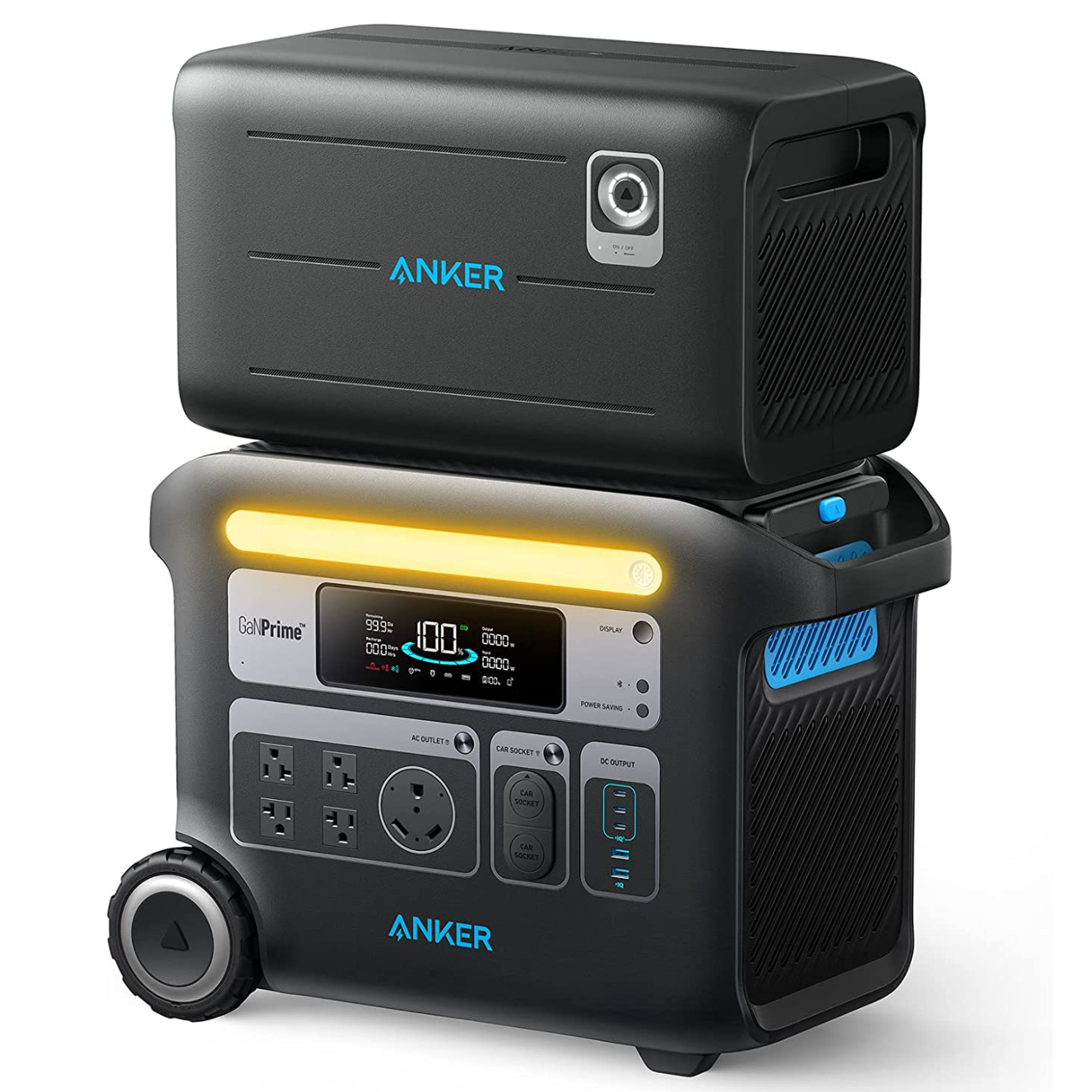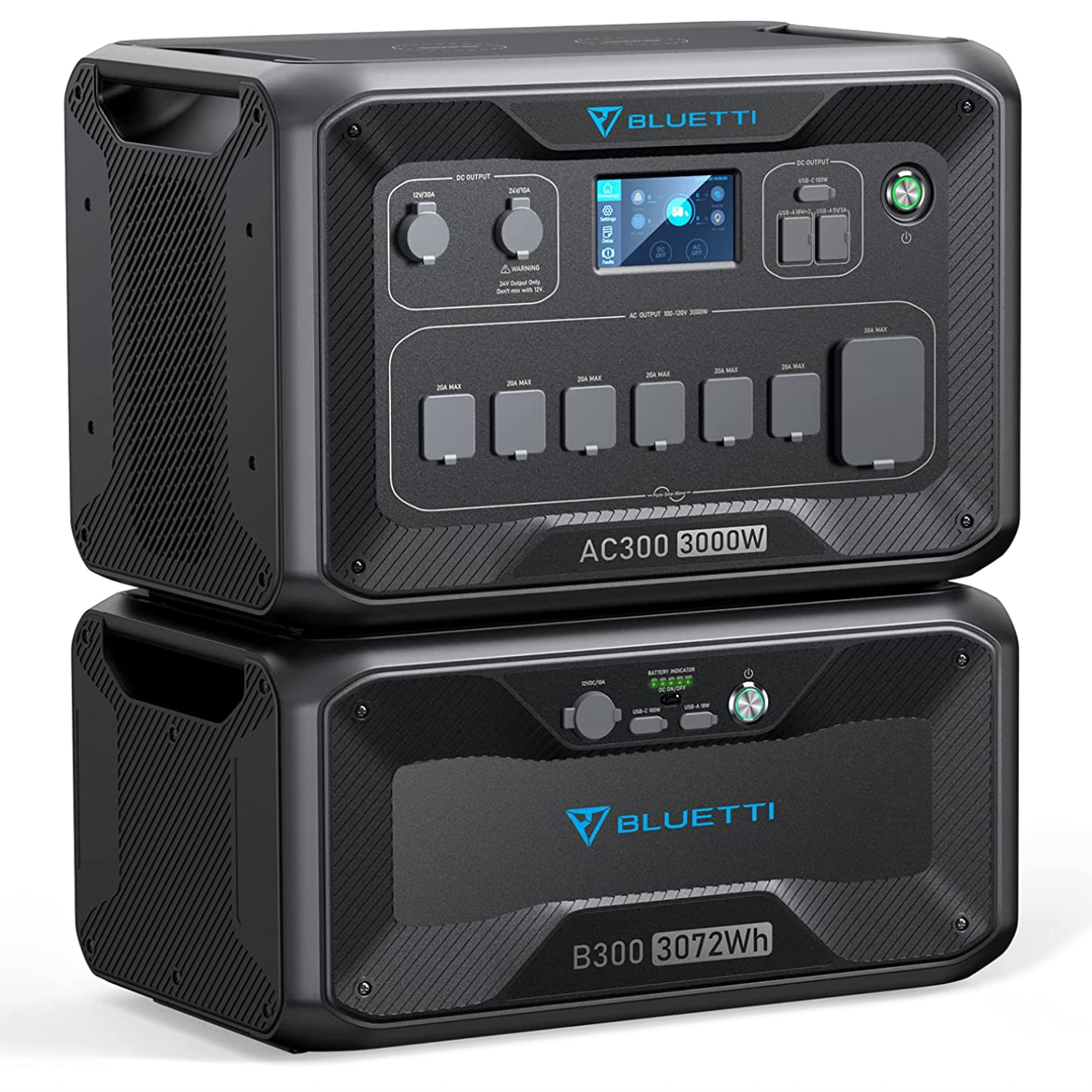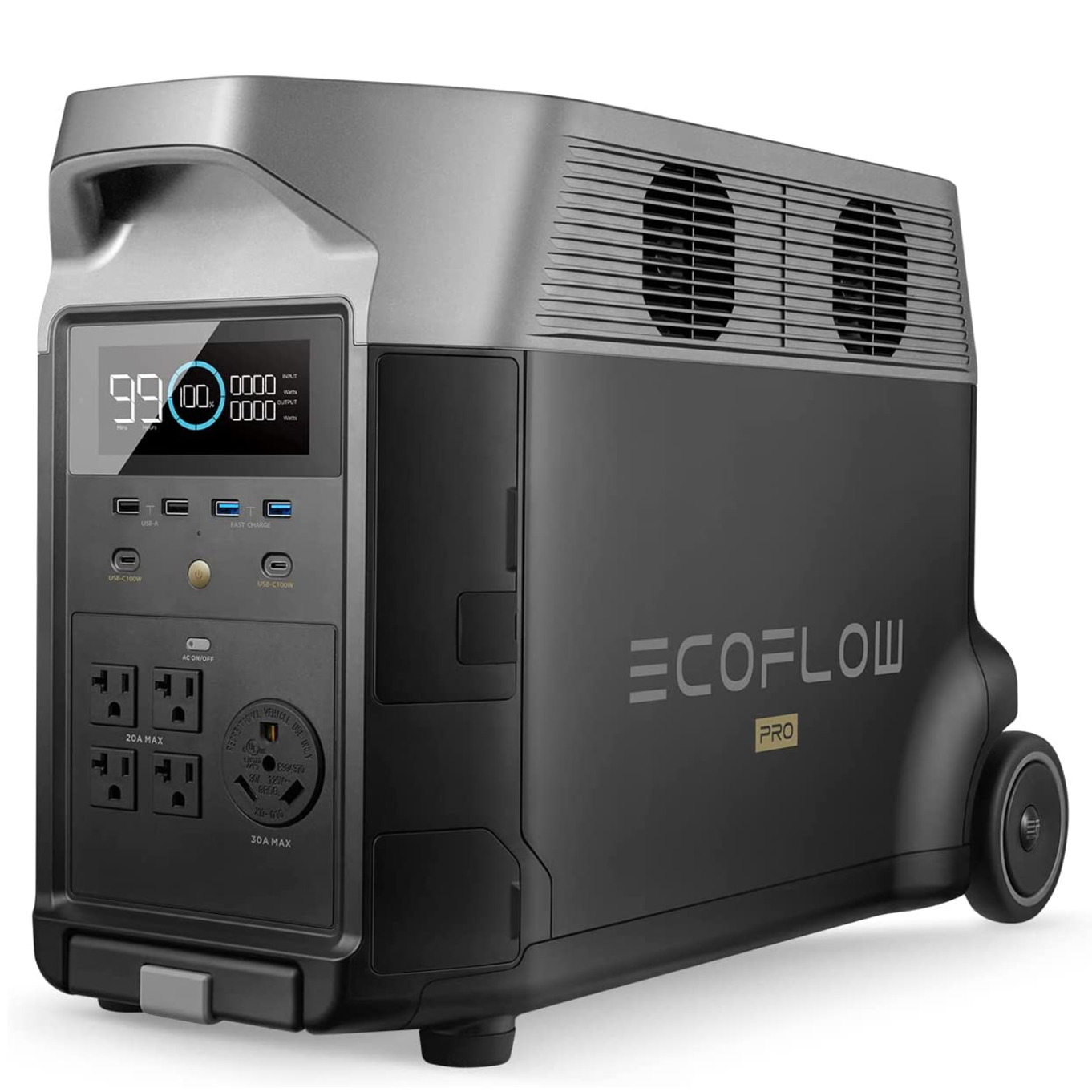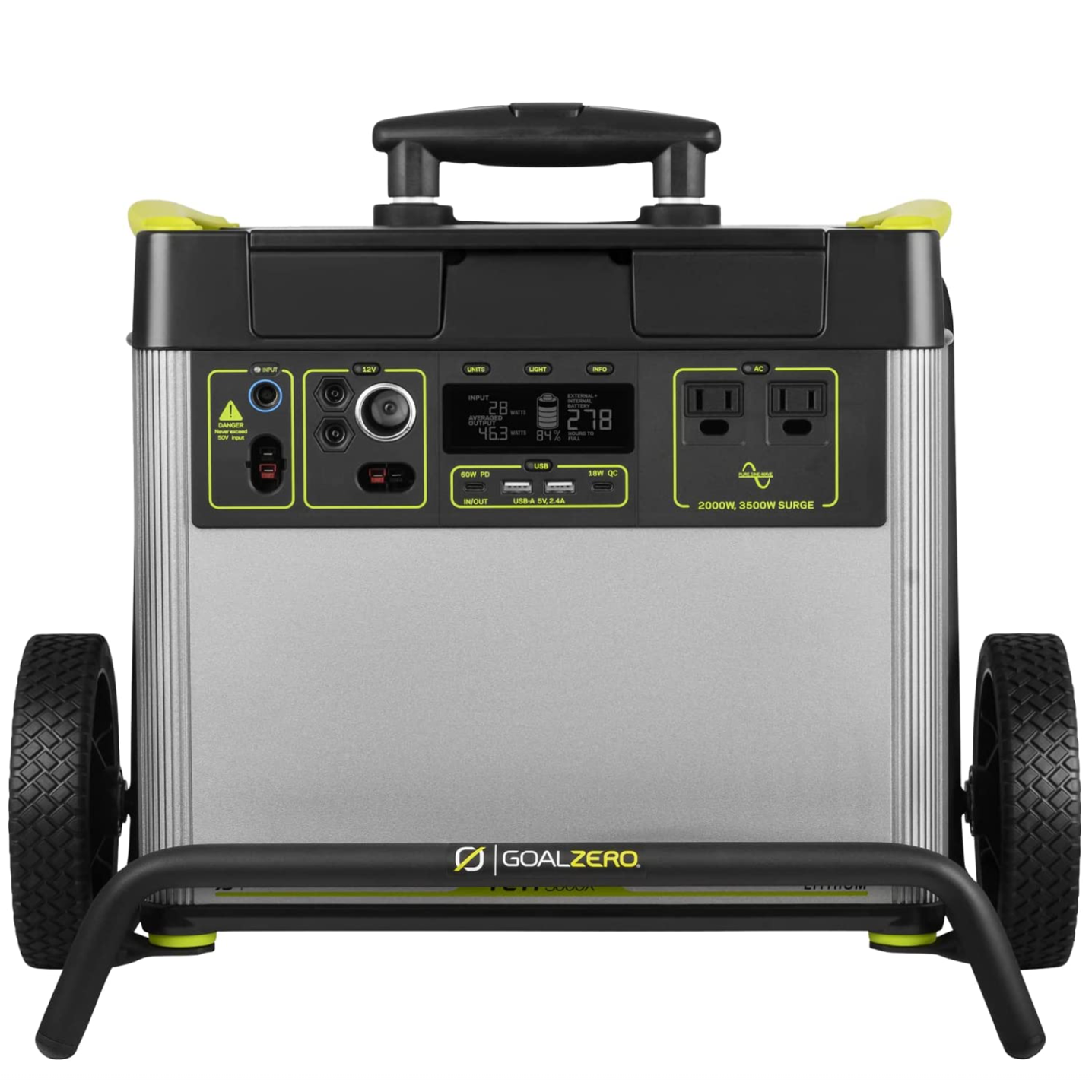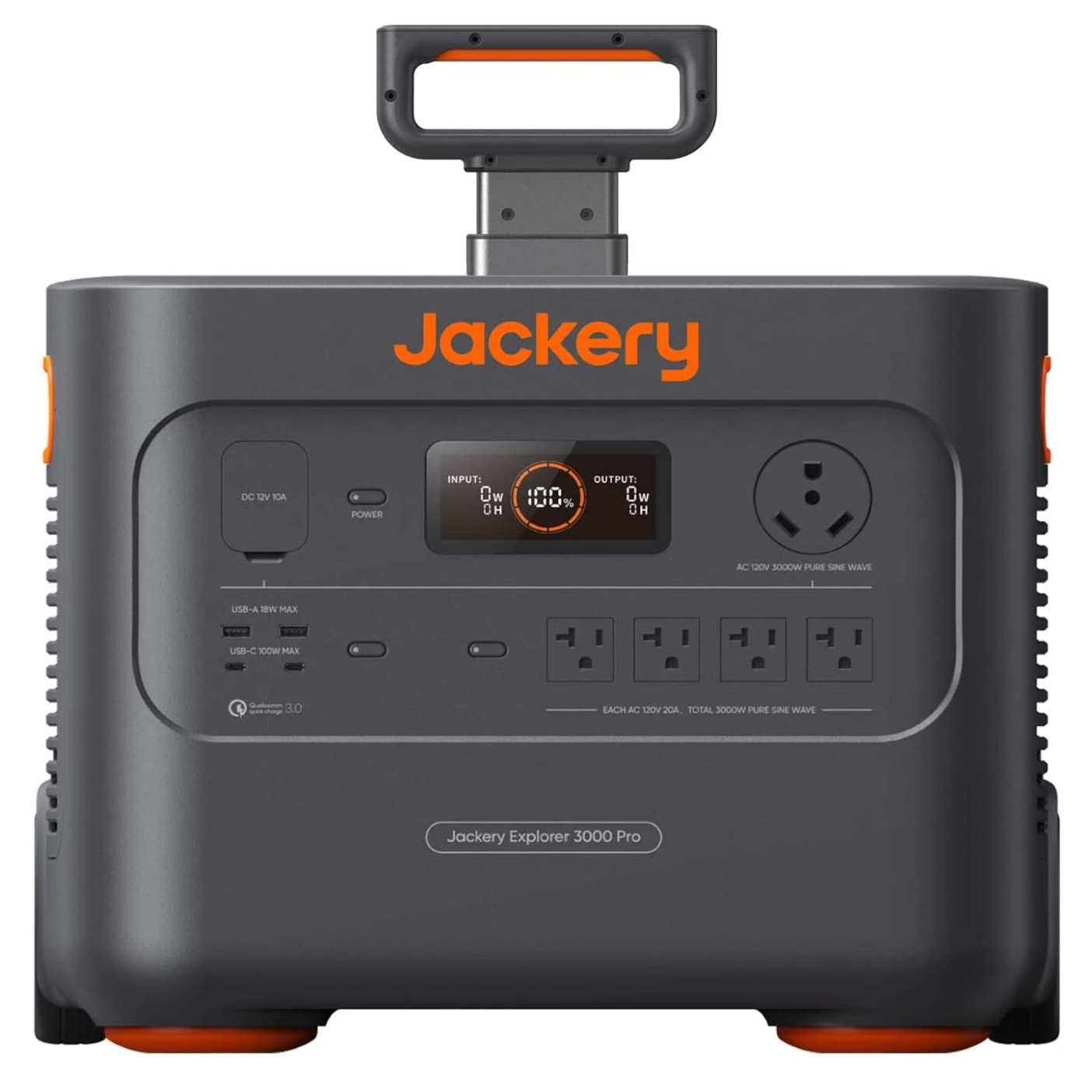The Best Portable Power Station

When it comes to electrical systems, there are two clubs in the DIY nomadic living community - Those who build their own electrical systems component by component - and - those who opt for an all-in-one electrical system. Team DIY like the ability to control each component of their system, geek out on achieving impressive customized specs, control the size and layout of their systems, and will argue that their systems are better for a cheaper total cost. Team All-In-One, on the other hand, tend to value ease of installation, portability, and feature rich systems with minimal consideration of how the system is built. If you’re on Team DIY, this article is not for you, but if you’re Team All-In-one - read on!
Due to a tight build deadline, we opted to go with a portable power station. An all-in-one freed up valuable build time to ensure that we could get the other elements of our build completed before we literally lost the roof over our heads. When we were designing our build in 2018, Goalzero was the clear leader in portable power stations when comparing specs. The portable power station market has exploded due to the pandemic, recent battery advancements, and the popularity of the DIY movement. Is Goalzero still the gold standard 5 years later? Read on and find out!
CLICK to see how we set up a power station in our build
Jump to:
Electric Power Station Terms
Comparison Chart
Power Station Reviews
Winners
Before we get to comparing systems, it’s important to understand some terminology so that you truly appreciate the components of each power station. Read through this list to better grasp the main components of each system.
Terminology:
Alternating Current (AC): Current that flows in alternating directions periodically through a wire. Devices that require a two or three-prong cord are wired in AC like the devices in your home.
Direct Current (DC): Current only flows in one direction. Cars are wired in DC and many devices in your build such as a roof fan, water pump, LED lights, composting toilet fan, and Wi-Fi router will use DC power.
Amperes (Amps): This is the measure of current in a system. The current is analogous to the flow rate of water in a pipe, which is defined by how quickly a specific volume of water is moving through a pipe. So, in a way, Amps are measuring the speed of electricity in a system measured in “volume”.
Voltage (Volts): Voltage is measured in volts. In our water analogy, Voltage is the amount of pressure in the system (which should be considered a constant in our example), so increasing the voltage (pressure) will also increase the current (amps).
Wattage (Watts): This is the product of volts x amps, which is defined as P (power) in your system.
Amp Hour (AH): Not to be confused with the measure of amps above, Amp Hour is a theoretical measure that defines the capable charge of a battery by stating how many continuous amps could be drawn from a battery in one hour. This isn’t a practical measure for DIY van build needs, but what is of value is higher numbers means more stored power, while lower numbers means less stored power.
Watt Hour (WH): This is a measure of power over time (an hour) which is another way of stating capacity of a battery. A battery that is 12v and 100Ah (amp hours) is converted to watt-hours by multiplying the two. So 12V x 100AH = 1200WH. The larger the WH, the higher the capacity of the battery.
Charge Controller: Regulates the amps and voltage from the charging source. They control the charging of the batteries and will stop charging when the battery is full.
MPPT Controller: MPPT is an acronym for Maximum Power Point Tracking which is an algorithm that maximizes the rate of electricity delivered from your solar panels to your Charge Controller. These algorithms organize the incoming electricity to charge your power station more quickly. (Roughly 15 - 30% faster than charging without an MPPT controller)
Inverter: An inverter converts DC power to AC power for devices that run off of AC power. There is a loss during this conversion (which is expressed as heat), so it is always better to wire anything in your build to run off of DC power, if possible. Inverters are rated by watts, such as, 2000w. In the 2000w example, this means you can run one or more AC devices simultaneously, so long as they do not draw more than 2000w combined. Sine-Wave technology is a feature that should be considered in an inverter, as it delivers power that is suitable for sensitive equipment, such as laptops.
Surge Protection: This is a feature of the inverter. Many AC devices “surge” when started. This means that they temporarily create a power spike that is over their operational rating. Refrigerators are a classic example of an appliance that spikes briefly (Peak Wattage) when their compressor starts, but then quickly drops to its spec’d power rating (Continuous Wattage). Surge protection will account for this quick spike. Our Goalzero has a 2000w inverter with 3500w surge protection.
Life Cycles: The number of charge and discharge cycles that a battery can complete before losing performance.
Lithium-ion (Li-Ion) Battery: Batteries containing a liquid electrolyte. The liquid electrolyte can leak, making this battery type less safe than Li-Po batteries. Li-Ion technology is more widespread and tends to be cheaper than Li-Po batteries. Li-Ion batteries can hold roughly 4 times the charge of Li-Po, using comparable mass - thus making Li-Ion more popular in consumer electronics, as the batteries are smaller.
Lithium-polymer (Li-Po) Battery: Batteries containing a gel-like electrolyte. Current Li-Po batteries tend to have a shorter lifespan due to the gel-like electrolyte hardening over time. These batteries can charge much faster than Li-Ion batteries. Using a gel-like chemistry allows Li-Po to be used in many shapes, making this an increasingly attractive option. Power stations using Li-Po batteries in this article will be noted as LiFePO, as they use Fe (Iron) for the cathodes in the battery.
Lead-acid Battery: Typically found in cars, these batteries are larger than lithium, don’t have a similar storage capacity relative to weight, have many fewer lifecycles, can only be used (depth of charge) to 50% capacity vs 80% for lithium, and charge more slowly. They are cheaper, however. Don’t use them. These batteries are an aging technology.
What we’re comparing
We are comparing six power stations in this article and our comments will be skewed towards nomads, as that is where our experience lies. Obviously, these power stations are great for off-grid living, using electric tools off the grid, home power backups, and other uses, but we will save that article for someone else. We chose units that are all roughly 3000WH, as this is a way to create a somewhat even playing field, and it’s a reasonable amount of power to have in your nomadic rig. This being said, we are using a Goalzero 6000x (with 6,071WH), as we use electricity for cooking/heating/hot water and powering 2 laptops daily for work. Check out our article on calculating your power needs for sizing your system.
The criteria we are using to determine the best power station for nomads is based on:
Battery Capacity (measured in Watt-hours)
Battery Chemistry
Inverter Specs
Max Solar input
Output Options
Wireless Connectivity
Cost
These and many other specs for each power station are noted in the table below.
| Portable Power Station Comparison | ||||||
|---|---|---|---|---|---|---|
| BRAND | Anker | Bluetti | EF Ecoflow | Goalzero | Jackery | Pecron |
| MODEL | 767 Station + 760 Battery | AC300 and B300 | 3600w DELTA Pro | Yeti 3000X | Explorer 3000 Pro | E3000 |
| PRICE | $2999- | $3498- | $3199- | $3500- | $2799- | $1599- |
| CAPACITY | 4096wh | 3072WH | 3600Wh | 3,032Wh | 3,024Wh | 3108Wh |
| BATTERY CHEMISTRY | LiFePO | LiFePO | LiFePO | Lithium-Ion | Lithium-Ion | Lithium-Ion |
| LIFE CYCLES | 3000+ | 3500 Cycles @ 80% | 3500 Cycles @ 80% | 500 Cycles @ 80% | 2000 Cycles @ 70% | 1000+ Cycles @ 80% |
| INVERTER | 2400w | 3000w | 4500w | 2000w | 3000w | 2000w |
| SURGE | 3600w | 6000w | 7200w | 3500w | 6000w | 4000w |
| INPUT AC CHARGER | 120v ~ 4hrs | 120v 30A ~ 1.5hrs | 120v ~ 3hrs | 120v ~ 14hrs | 120v ~2.4hrs | 120v ~ 3hrs |
| INPUT ALTERNATOR OR CAR PORT CHARGING | No | 12v Car Port Only | 12v Car Port Only | Car Port or Alternator with accessory | 12v Car Port Only | 12v Car Port Only |
| INPUT MAX SOLAR (WATTS) | 1000w | 2400w | 1600w | 600w | 1400w | 1300w |
| MAX SOLAR INPUT V/A | 60v/20A | 150v/12A | 150v/15A | 50v/50A | 60v/24A | 95v/15A |
| MPPT TECHNOLOGY | Yes | Yes | Yes | Yes | Yes | Yes |
| PURE-SINE WAVE | Yes | Yes | Yes | Yes | Yes | Yes |
| OUTPUT 120v 20A OUTLETS | 4 | 6 | 4 | 2 | 4 | 6 |
| OUTPUT 120v 25A/30A OUTLETS | 1 (30A) | 1 (30A) | 1 (30A) | 0 | 1 (25A) | 0 |
| OUTPUT 12v CAR PORT | 2 | 2 | 1 | 1 | 1 | 1 |
| OUTPUT USB-A PORTS | 2 | 4 | 4 | 2 | 2 | 4 |
| OUTPUT USB-C PORTS (5v) | - | - | - | 1 | 0 | 0 |
| OUTPUT USB-C PD PORTS | 3 @ 100w | 1 @ 100w | 2 @ 100w | 1 @ 60w | 2 @ 100w | 2 @ 100w |
| OUTPUT WIRELESS DEVICE CHARGING | No | Yes | No | No | No | Yes |
| BLUETOOTH/WI-FI CONNECTIVITY | Bluetooth Only | Both | Both | Both | Both | No |
| CHAIN ADDT'L BATTERIES | Yes - 1 | Yes - Multiple | Yes - Multiple | Yes, with accessory | No | No |
| WEIGHT (LBS) | 112.9 lbs | 131.42 lbs | 98.8 lbs | 69.78 lbs | 63.9 lbs | 55 lbs |
| DIMENSIONS (LxWxH) | 20.7" x 9.8" x 25" | 20.5" x 12.5" x 24.6" | 25" x 11.2" x 16.4" | 15.3" x 10.2" x 13.6" | 18.6" x 14.1" x 14.7" | 16" x 10" x 11" |
| WARRANTY | Yes, 5 YEAR | Yes, 2 YEAR | Yes, 5 YEAR | Yes, 2 YEAR | Yes, 5 YEAR | Yes, 1 YEAR |
| AVERAGE AMAZON CUSTOMER RATING | 4.3 / 5 STARS | 4.3 / 5 STARS | 4.6 / 5 STARS | 4.5 / 5 STARS | 3.8 / 5 STARS | 4.5 / 5 STARS |
| PRICE PER WH | $0.73 per WH | $1.14 per WH | $0.89 per WH | $1.15 per WH | $0.93 per WH | $0.52 per WH |
| https://amzn.to/3LIay3M | https://amzn.to/42BBY1W | https://amzn.to/3M4OZvs | ||||
| https://amzn.to/42dbWSR | https://amzn.to/42BDdyq | https://amzn.to/3HQTCqu |
Anker Powerhouse 767 + 760 Expansion Battery
4096WH Capacity LiFePO w/ 12 output ports
The Powerhouse 767 is a tall, slender unit that has built-in wheels and a handle for easy portability. The bright display is the largest of the 6 units, and has an integrated LED light bar. The station is nice looking and the output ports are arranged intuitively, which will make it easy to plug in multiple devices simultaneously.
The Powerhouse 767 on its own provides 2048WH of capacity and is doubled to 4096WH with the addition of the 760 Expansion battery. This set up has the largest capacity of all stations in this comparison. The Anker unit uses LiFePO battery chemistry, which provides fast charge times, 3000+ life cycles, and provides some peace of mind, as this chemistry is considered safer than Li-Ion. Monitoring of the system on an app is available via Bluetooth, but Anker does not offer Wi-Fi connectivity to the unit, which we find to be a bummer.
The Powerhouse 767 has a 2400w inverter using sine-wave technology with 3600w surge protection. The 2400w spec is near the bottom of the compared units, but is plenty of power to run multiple power hungry devices at the same time. Drawing more than 2400w simultaneously will trip the onboard breaker, so make sure to understand which devices you can run at the same time to avoid this.
The Powerhouse 767 has 12 different outputs, which ranks in the middle of our comparison: An exclusive 30A RV port, 4 AC 20A outlets with a wattage of up to 2400W, 3 USB-C (100w) charging ports, 2 USB-A ports, and 2 car ports (what use to be called the cigarette lighter).
As for charging, the Anker unit can charge with up to 1000w of solar panels. This is the fifth best of the 6 units in our comparison, but is most likely more than anyone is going to be able to fit on their camper roof (for comparison, we have 730w on our van roof, which takes up nearly all of it). Sadly, the Powerhouse 767 does not offer car port (cigarette lighter) charging or alternator charging from your vehicle. This leaves you the option to use solar or to plug the unit in to a 120v outlet. 120v outlet charging is quoted at charging from empty to full in 4 hours.
The Anker Powerhouse 767 and 760 Expansion Battery is offered together for $2999.00 at the time of writing, which includes a 5-year warranty. This works out to $0.73 per watt-hour, which is the second best in this comparison and the cheapest for all LiFePO units.
What we love:
The price per Watt-Hour is the best of the LiFePO stations
Large 4096WH LiFePO capacity
2 12v car ports for connecting to 12v devices in your build
What we don’t:
Could use more 12v outlets for camper build components
Would be more attractive with a larger inverter
Heavy, but to be expected with that much battery capacity
No option for any type of charging from vehicle
No Wi-Fi connectivity option with the app
CHECK THE CURRENT PRICE OF THE ANKER POWERHOUSE 767
Bluetti AC300 + B300 Expansion Battery
3072WH Capacity LiFePO w/ 19 output ports
The Bluetti AC300 is a tall, slender unit with built-in handles for portability. The backlit display is of average size relative to the other units. We like that the front face is inset, which may help to not accidentally bump into and unplug cords that are plugged into it. This unit (with the addition of the B300) is the heaviest in our comparison at nearly 132lbs! We don’t see this as an issue though if it’s always going to stay in your camper.
The AC300 on its own does not have storage capacity. It is part of a component system and handles the input and output of power, including the inverter and charge controller. You must purchase B300 units, which are the battery component of the system. Each B300 unit has 3072WH of capacity, which is expandable up to 12,288Wh (with 4 B300’s). Bluetti uses LiFePO battery chemistry, which provides fast charge times, 3000+ life cycles, and provides some peace of mind, as this chemistry is considered safer than Li-Ion. Monitoring of the system on an app is available via Bluetooth and Wi-Fi connectivity.
The AC300 has a 3000w inverter using sine-wave technology with 6000w surge protection. This is tied for second best along with the Jackery Explorer 3000 Pro in our comparison. 3000w inverters will allow you to run a number of devices - including an electric hot water heater -or- induction stove - at the same time.
The Bluetti AC300 has 16 (!) different output ports, which ranks number one in our comparison: A 30A RV port, 6 AC 20A outlets with a wattage of up to 3000W, 1 USB-C (100w) charging ports, 4 USB-A ports, 2 car outlets (cigarette lighter), and two 15w wireless charging pads on the top of the unit. Additionally, the B300 battery has 1 USB-C (100w) charging port, 1 USB-A port, and 1 12v/10A car port for a combined total of 19 output ports!
As for charging, the Bluetti AC300 can charge with up to 2400w of solar panels. This is the most of the 6 units compared. You’ll never get that much solar on a van, but could be done on a Class C or school bus. The unit can be charged via car port (cigarette lighter) charging, but alternator charging from your vehicle is not offered. 120v wall charging is an option with the included 15A plug. A 30A plug is available for purchase, which will charge the unit from empty to full in approximately 1.5 hours.
The Bluetti AC300 + B300 is offered at $3498.00 at the time of writing, which includes a 2-year warranty. This works out to $1.14 per watt-hour, which is the second most expensive in this comparison and the most expensive for all LiFePO units.
What we love:
The ability to expand to up to 4 batteries
Massive solar charging option
Very fast AC charging
Most in class output ports
What we don’t:
$0.25 more expensive per WH compared to competition
2-year warranty compared to competition
Very heavy considering capacity
CHECK THE CURRENT PRICE OF THE Bluetti AC300 + B300 combo
YOU MAY LIKE THE OLDER AC200MAX WITH MORE CAPACITY CLICK FOR PRICE
Ecoflow DELTA Pro
3600 WH capacity LiFePO w/ 15 output ports
The Ecoflow 3600w DELTA Pro is a tall, slender unit with a built-in handle and a set of wheels for portability. The illuminated display is easy to read and all the output ports are located below the info screen on the narrow side of the unit. The DELTA Pro is the only power station on our list that prioritizes one of the narrow sides of the unit as the “main face”. This could create some crowding when plugging in many devices at once, and it may make access to the panel difficult in some orientations in your camper. This power station comes in at 98.8lbs, the third heaviest in our comparison.
The DELTA Pro has a capacity of 3600WH, with the option to link one or two DELTA Pro Smart Extra Batteries for a max total capacity of 10,800Wh. Ecoflow uses LiFePO battery chemistry, which provides fast charge times, 3000+ life cycles, and provides some peace of mind, as this chemistry is considered safer than Li-Ion. Monitoring of the system on an app is available via Bluetooth and Wi-Fi connectivity.
The DELTA Pro has a 4500w inverter using sine-wave technology with 7200w surge protection. This is the highest rated inverter in our comparison. A 4500w inverter allows you to run a number of devices - including high demand appliances such as an electric hot water heater or induction stove - at the same time.
The Ecoflow has 15 different output ports, which ranks second in our comparison: A 30A RV port, 4 AC 20A outlets with a wattage of up to 4500W, 2 USB-C (100w) charging ports, 4 USB-A ports, 1 car outlet (cigarette lighter), 1 Anderson Port and 2 12v DC5521 38w ports.
As for charging, the Ecoflow DELTA Pro can charge with up to 1600w of solar panels. This is the second most of the 6 units compared. You’d be very hard-pressed to get that much solar on a van, but could easily be done on a Class C or school bus. The unit can be charged via car port (cigarette lighter) charging, but alternator charging from your vehicle is not offered. 120v wall charging is an option with the included 15A plug and will charge the station in 2.7 hours. A 240v plug is available for purchase, which will charge the unit from empty to full in approximately 1.8 hours. One thing that the Ecoflow offers that none of the other options offer is the ability to charge the power station from an EV station.
The Ecoflow DELTA Pro is offered at $3199.00 at the time of writing, which includes a 5-year warranty. This works out to $0.89 per watt-hour, which is the second-best price for the LiFePO units.
What we love:
The price per Watt-Hour is very competitive
The ability to chain two additional batteries
Best in class inverter and surge protection
Lightest of the LiFePO units in this article
4 12v output ports
What we don’t:
Questionable location for display and ports
Additional batteries do not nest/attach to main unit
CHECK THE CURRENT PRICE OF THE Ecoflow Delta pro
Goalzero Yeti 3000x
3032WH capacity Li-ion w/ 11 output ports
The Goalzero Yeti 3000x is a squat, rectangular unit with two handles. It also comes with a removable wheeled tote that has an extending handle for longer moves. The illuminated display is fairly easy to read, and most output ports are located to the sides and below the info screen. The station has a large lid on the top, housing reset and communication buttons, a few additional ports, and empty slots for expansion modules. This power station comes in at nearly 70lbs, which is the heaviest of the Li-ion batteries in our comparison.
The Yeti 3000x has a capacity of 3032WH, with the option to link to an unlimited amount of lead-acid batteries with an accessory that is sold separately (Link Expansion Module). Goalzero uses Li-ion battery chemistry which charges more slowly than LiFePO, only has around 500 life cycles, and is a less safe chemistry compared to LiFePO. Monitoring of the system on an app is available via Bluetooth and Wi-Fi connectivity. Since we own a Goalzero, we can say that connectivity is spotty, and we have to re-pair the unit to our phones more often than we care to.
The Yeti 3000x has a 2000w inverter using sine-wave technology with 3500w surge protection. This ranks last as the lowest rated inverter in our comparison. 2000w inverters will allow you to run a number of devices - including an electric hot water heater -or- induction stove (on lower settings).
The Goalzero has 11 different output ports, which ranks fifth in our comparison: 2 AC 20A outlets with a wattage of up to 2000W, 1 USB-C (60w) charging port (can also be used as a charging input), 1 USB-C (18w) port, 2 USB-A ports, 1 car outlet port (cigarette lighter), 2 6mm 12v ports, and 2 12v High Power Ports (360W). The variety of output ports is truly the best feature of this power station.
As for charging, the Goalzero can charge with up to 600w of solar panels. This is the least of the 6 units compared. The unit can be charged via car port (cigarette lighter) charging, and alternator charging is available with the purchase of the Link Expansion Module, which is the reason we originally went with Goalzero. 120v wall charging is an option with the included 230w plug and will charge the station in 14 hours. A 600w power supply can be purchased additionally, which will charge the unit in 6 hours.
The Goalzero Yeti 3000x is offered at $3500.00 at the time of writing, which includes a 2-year warranty. This works out to $1.15 per watt-hour, which is the most expensive of all units reviewed.
What we love:
Lots of 12v output options for camper builds
The ability to charge via alternator with separate accessory
What we don’t:
Most expensive unit per watt-hour in this comparison
Allows for the least amount of charging via solar panels
Inverter spec is the worst in the group
USB-C PD is 60w and not 100w
Only two 120v outlets
Link expansion only supports lead-acid batteries
Li-ion chemistry means slower charge times
2-year warranty
CHECK THE CURRENT PRICE OF THE goalzero yeti 3000x
Jackery Explorer 3000 Pro
3024WH capacity Li-ion w/ 10 output ports
The Jackery Explorer 3000 Pro is a squat, rectangular unit with two embedded handles on the side, as well as a built-in wheeled tote. The illuminated display has a high degree of contrast and is easy to read, and the output ports are located to the sides and below the info screen. This power station comes in at nearly 64lbs, which is the 2nd lightest of the batteries in our comparison.
The Explorer 3000 Pro has a capacity of 3024WH. Jackery uses Li-ion battery chemistry which charges more slowly than LiFePO, only has around 500 life cycles, and is a less safe chemistry compared to LiFePO. Monitoring of the system on an app is available via Bluetooth and Wi-Fi connectivity.
The Explorer 3000 Pro has a 3000w inverter using sine-wave technology with 6000w surge protection. This combination is tied for the second best rated inverter in our comparison. 3000w inverters will allow you to run a number of devices - including an electric hot water heater -or- induction stove - at the same time.
The Jackery has 10 different output ports, which ranks last in our comparison: A 25A RV port, 4 AC 20A outlets with a wattage of up to 3000W, 2 USB-C (100w) charging ports, 2 USB-A ports, and 1 car outlet (cigarette lighter).
As for charging, the Explorer can charge with up to 1400w of solar panels. This is the third best of the units compared. The unit can be charged via car port (cigarette lighter) charging in 35 hours. Alternator charging is not available. 120v wall charging is an option and will charge the station in 2.4 hours according to the manufacturer.
The Jackery Explorer 3000 Pro is offered at $2799.00 at the time of writing, which includes a 3-year warranty. This works out to $0.93 per watt-hour, which is the 3rd least expensive of all units reviewed.
What we love:
Solid Inverter specs
Highest solar charging capability of Li-ion stations
Fast 120v AC charging according to the manufacturer
What we don’t:
Needs more 12v outlets (only 1) for camper build components
Lowest Amazon customer rating in this comparison
Largest power station of Li-ion units
CHECK THE CURRENT PRICE OF THE Jackery Explorer 3000 Pro
Pecron
E3000
3108WH capacity Li-ion w/ 14 output ports
The Pecron E3000 is a squat, rectangular unit with two embedded handles on its widest sides. A small detachable trolley with a telescoping handle is included for easier transport. The illuminated display is fairly easy to read, and the output ports are located to the sides and below the info screen. This power station comes in at 55lbs, which is the lightest of all batteries in our comparison.
The E3000 has a capacity of 3024WH. Pecron uses Li-ion battery chemistry which charges more slowly than LiFePO, only has around 500 life cycles, and is a less safe chemistry compared to LiFePO. Monitoring of the system on a phone app is NOT available for either Bluetooth or Wi-Fi connectivity.
The E3000 has a 2000w inverter using sine-wave technology with 4000w surge protection. This combination ranks fifth in our comparison. 2000w inverters will allow you to run a number of devices - including an electric hot water heater -or- induction stove (on lower settings).
The Pecron has 14 different output ports: 6 AC 20A outlets with a wattage of up to 2000W, 2 USB-C (100w) charging ports, 4 USB-A ports, 2 DC5521 ports, 1 car outlet (what use to be called the cigarette lighter), and 1 15w wireless charging port on the top of the station.
As for charging, the E3000 can charge with up to 1200w of solar panels. This is the forth best of the units compared. The unit can be charged via car port (cigarette lighter) charging in 31 hours per the manufacturer. Alternator charging is not available. 120v wall charging is an option and will charge the station in 6 hours. An additional 120v wall charger can be purchased, allowing the power station to be charged in 3 hours using both 120v cords.
The Pecron E3000 is offered at $1599.00 at the time of writing, which includes a 1-year warranty. This works out to $0.52 per watt-hour, which is the least expensive of all units reviewed.
What we love:
The price per Watt-Hour is the cheapest
Lightest power station in the comparison
Fast 120v AC charging (with additional cord sold separately)
Good solar charging capabilities
Large number of output ports
What we don’t:
Could use more 12v outlets for camper build components
Larger inverter would be preferred
No Bluetooth or Wi-Fi connectivity
1-year warranty
CHECK THE CURRENT PRICE OF THE Pecron E3000
Our Winner
Ecoflow
DELTA Pro
With a best in class inverter, fast AC charging, 1600w of solar input, and plenty of output ports, this power station is our top pick. Expandable up to 10,800Wh, this unit will grow with you and is cheaper per watt-hour than some Li-ion units. This unit also holds the highest user rating on Amazon of all units compared.
Budget Pick
Pecron
E3000
If price is your main consideration, this is the power station for you. With comparable or better specs than others in its class, the Pecron E3000 is offered at half the price of the competition. For peace of mind, we’d suggest buying a 3-year Asurion warranty through Amazon to protect your purchase, as the manufacture’s warranty is only 1-year.

